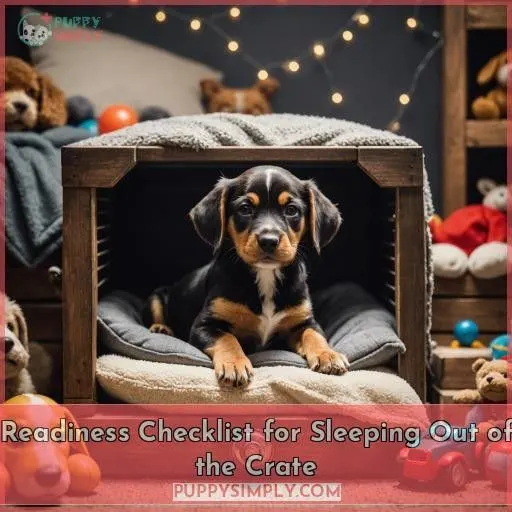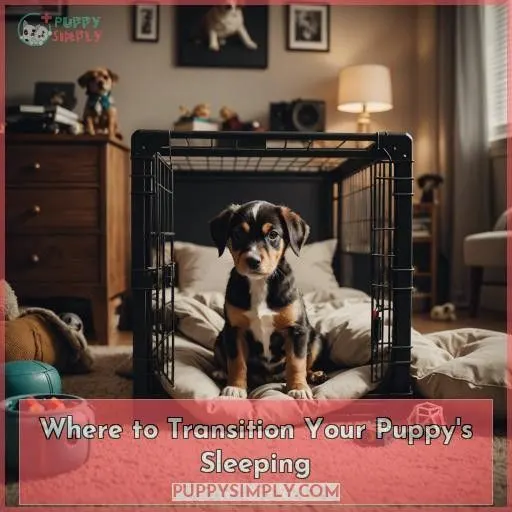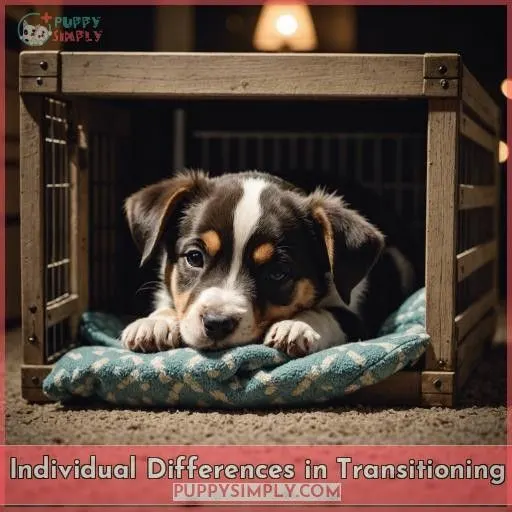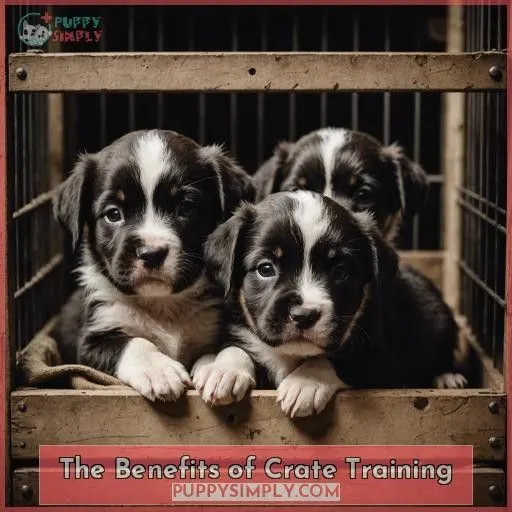This site is supported by our readers. We may earn a commission, at no cost to you, if you purchase through links.

Being fully housebroken
Not chewing or causing destruction when left alone
Sleeping through the night without accidents
Other factors, like having a puppy-proofed home and no other pets, also indicate readiness.
Start by leaving the crate open during nighttime, then shift to crating just during the day.
With patience and positive reinforcement, you can successfully move your pup’s sleeping area outside the crate – but take it gradually to set them up for success.
Continue reading for a thorough guide on making this transition smoothly.
Table Of Contents
- Key Takeaways
- Readiness Checklist for Sleeping Out of the Crate
- Teaching Your Puppy to Sleep Outside the Crate
- Stopping Crate Use for Daytime
- Puppy Supplies for Transitioning Out of the Crate
- The Importance of Puppy-proofing Your Home
- Where to Transition Your Puppy’s Sleeping
- Factors for a Successful Transition
- Individual Differences in Transitioning
- The Benefits of Crate Training
- Frequently Asked Questions (FAQs)
- Conclusion
Key Takeaways
- Establish that your puppy is completely housetrained, does not exhibit destructive behaviors like chewing, and can sleep through the night without accidents before transitioning them out of the crate.
- Properly puppy-proof your home by removing or securing potential hazards, such as electrical cords, poisonous plants, and chewable items.
- Gradually introduce your puppy to sleeping outside the crate by leaving the crate door open at night, setting up a comfortable bed in a designated area, and using positive reinforcement training techniques.
- Consider individual differences in temperament, training progress, and preferences, as some puppies may transition out of the crate earlier or later than others, and some may prefer the security of a crate for sleeping.
Readiness Checklist for Sleeping Out of the Crate
Before letting your puppy sleep outside of the crate at night, make sure they’re thoroughly housebroken.
Ensure your home is safe for them to wander around without supervision.
It’s essential that your puppy doesn’t display any unsupervised chewing or destructive behaviors.
There should be no other pets in the home that could be a threat.
They must be able to reliably sleep through the night without incidents.
Potty Trained
You’ll want your pup completely housebroken before moving to an open crate or bed. Potty accidents are untidy and frustrating, chewing furniture and jumping on beds show poor manners. Make sure your pup takes to housebreaking and feels crate comfort before continuing.
Home is Safe for Roaming
Before allowing your puppy to roam freely, verify that your home is adequately puppy-proofed. Eliminate chewing hazards, establish designated safe roaming areas, and maintain constant surveillance to avert mischief or destruction.
No Unattended Chewing or Destruction
Before letting your puppy roam free, make sure they don’t gnaw on household items or wreck furnishings while you’re not watching. Consistent training, managing their environment, and providing them with suitable chew toys will help prevent destructive behaviors.
No Other Animals in the Home
Another significant factor is having no other pets in the home. Introducing a puppy to an existing pet can trigger:
- Territorial conflict
- Sibling rivalry
- Unsafe pet interactions
- Lack of a safe space
Having your puppy as the sole pet simplifies crate-free sleeping.
Sleeps Through the Night
Sleeping through the night shows your pup’s readiness to graduate from the crate. Establish a calming bedtime routine with potty breaks, quiet time, and cozy bedding in a puppy-proofed room.
Teaching Your Puppy to Sleep Outside the Crate
When moving your puppy to sleep outside the crate, make sure they’ve had a bathroom visit before bedtime and create a dark, cozy, and puppy-proofed room. Set up a camera to keep an eye on your pup, and leave the crate door open, allowing them to explore their new sleeping area slowly.
Ensure Bathroom Visit Before Bedtime
To prevent nighttime accidents, establish a bedtime routine including a final potty break before settling your pup into their cozy dog bed.
Puppy-proof a Room
Once your puppy grasps potty training, establish a puppy-proofed room with ample space. Eliminate chewables and distractions. Make sure the crate door is raised for easy access and place soft bedding nearby.
Create a Dark and Cozy Atmosphere
Make sure you create a dark, cozy atmosphere for your pup’s first night out of the crate. This assists in getting good sleep.
Set Up a Camera
You’ll also want to set up a camera with night vision and motion detection for monitoring your pup’s bedtime routine. Strategic camera placement allows live streaming, ensuring your furry friend rests safely in their cozy new digs.
Leave the Crate Door Open
After setting up a camera for peace of mind, leave the crate door open at night. This gradual shift reduces separation anxiety while getting your pup accustomed to a new night time routine. Incorporate clicker training for positive reinforcement.
Stopping Crate Use for Daytime
When you’re ready to move your puppy out of their crate during the day, make sure they’ve had a good walk or playtime before leaving to wear them out. You’ll also want to protect the crate area and provide a comfortable dog bed in another room to help your pup adjust to the new routine.
Ensure a Good Walk Before Leaving
Before leaving, take your pup on a long, engaging walk to tire them out. This provides necessary exercise, preventing boredom and destructive behaviors when left alone. Gradually increase unsupervised time and distance, ensuring proper leash manners.
Safeguard the Crate Area
When you’re out, safely confine your pup by: 1) Closing doors to tempting rooms, 2) Using pet gates, 3) Removing chewables, 4) Setting up a camera. This prevents separation anxiety, destructive behavior, and eases the adjustment period.
Place a Dog Bed in Another Area
Once your pup is the proper age and can safely roam, place a comfy bed in another area. Leave it there gradually for increasing durations, ensuring the spot is secure. Changing slowly will keep them comfortable.
Consider Structured Nap Times for Struggling Puppies
You might need structured naps if your pup struggles with daytime confinement.
- Schedule regular nap times
- Provide mental enrichment toys
- Make sure proper exercise comes before naps
Consistent nap routines help puppies settle and prevent destructive behavior.
Puppy Supplies for Transitioning Out of the Crate
You’ll need specific supplies to create a comfortable and safe space for your puppy when moving them out of their crate. Consider purchasing a durable metal or plastic crate, a plush orthopedic bed like the Midwest Quiet Time or Majestic Pet Suede, and baby gates such as the Summer Infant Safety Gate to confine your pup to designated areas.
1. Midwest Homes Dog Crate Life Stages
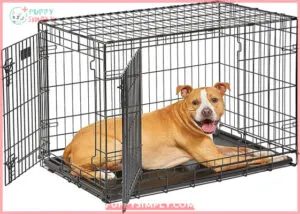
When moving your puppy out of the crate, consider the Midwest Homes Dog Crate Life Stages.
This sturdy metal crate measures 36x23x25 inches, perfect for intermediate breeds from 41-70 lbs.
It boasts enhanced security features like slide-bolt door latches with paw blocks, ensuring your pup stays safe.
The durable, leak-proof plastic pan makes cleanup a breeze, while the rounded corner clips provide a safer crate experience.
Assembled in seconds and portable for travel, this crate from a reputable Indiana-based company offers a secure den for your furry friend.
Best For: Intermediate dog breeds with an adult weight of 41 to 70 pounds.
- Enhanced security features like paw blocks on slide-bolt door latches
- Durable, leak-proof plastic pan for easy cleanup
- Rounded corner clips for a safer crate experience
- Only available in one size
- May be too small for some intermediate breeds
- Assembly instructions may not be clear
2. Bowsers Double Donut X Large Cowboy

The Bowser’s Double Donut X Large Cowboy provides the ultimate comfort for your pup when moving out of the crate.
Its leather-like brown cover, tufted cushion, and removable orthopedic foam insert offer unmatched luxury.
With its zipper covers and quality construction, this bed is a true investment piece that will outlast your furry friend’s puppy years.
Whether you’re securing your pet’s new favorite resting spot in the living room or establishing a cozy bedroom retreat, this bed’s dimensions and chew-proof design make it an ideal transitional sleeping space.
Best For: Your pup when moving out of the crate.
- Unmatched luxury with its leather-like brown cover, tufted cushion, and removable orthopedic foam insert
- A true investment piece that will outlast your furry friend’s puppy years
- Ideal transitional sleeping space with its dimensions and chew-proof design
- Took some time for the customer’s dog to get used to
- Might be too big for some pets
- May be expensive for some people
3. Majestic Pet Suede Calming Dog Bed
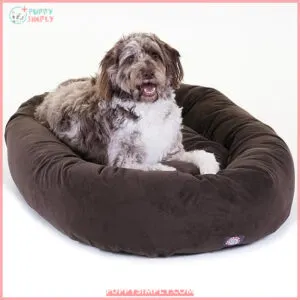
The Majestic Pet Suede Calming Dog Bed is an exceptional choice for your pup’s journey beyond the crate.
Its luxurious cushion and bolster provide unmatched comfort, embracing your furry companion’s head and offering spinal support.
The water-resistant base prevents mishaps, making it a prudent investment.
Additionally, its chic donut shape adds a touch of refinement to your home’s aesthetics.
You can effortlessly machine wash it for seamless cleaning, ensuring a fresh and cozy environment for your pup’s blissful dreams.
Best For: Dogs seeking comfort and support beyond the crate.
- Provides unmatched comfort with a plush cushion and supportive bolster.
- Water-resistant base prevents accidents and ensures easy cleaning.
- Elegant donut shape enhances home décor.
- Not suitable for heavy chewers.
- May not be suitable for very large breeds.
- May require occasional fluffing to maintain shape.
4. Midwest Quiet Time Orthopedic Nesting Dog Bed
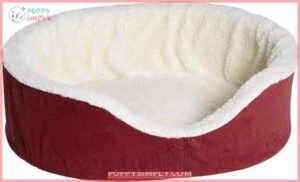 View On Amazon
View On Amazon For the ultimate in comfort, you’ll want to contemplate the Midwest Quiet Time Orthopedic Nesting Dog Bed.
Its convoluted, egg crate foam offers superior orthopedic support.
The zippered, machine-washable cover and cozy liner make it a cinch to keep clean.
With five attractive colors and sizes ranging from 17.5 to 42 inches, you’re sure to find the ideal fit for your pup’s new sleep sanctuary.
Trust me, your furry friend will thank you for this luxurious upgrade from the crate.
Best For: Dogs who need orthopedic support and a cozy place to nest.
- Convoluted, egg crate foam provides orthopedic support
- Zippered, machine-washable cover and cozy liner for easy cleaning
- Five attractive colors and sizes ranging from 17.5 to 42 inches to fit any dog
- Foam is not the greatest quality
- Fleece liner is too thin and poorly made
- Foam has fallen apart in some cases
5. Summer Infant Decorative Extra Tall Safety Gate

To keep your puppy safely contained while allowing freedom, you’ll want the Summer Infant Decorative Extra Tall Safety Gate.
This sturdy, steel gate fits openings from 28.5 to 48 inches wide and stands a towering 36 inches tall—squeezing through is nearly impossible.
The walk-through door swings both ways for easy access, yet securely locks to prevent escapees.
With narrowly spaced bars, even the craftiest pup can’t wedge their way out.
Plus, the pressure mount requires no tools, so you can puppy-proof any room in minutes.
Best For: Pet owners who need to keep their pups safely contained.
- Fits openings from 28.5 to 48 inches wide and stands 36 inches tall.
- Walk-through door swings both ways for easy access and securely locks to prevent escapees.
- Narrowly spaced bars prevent even the craftiest pup from escaping.
- May require adjustments after a few months of use.
- Can be loud when closing automatically.
- Bars may be too far apart, allowing for a child’s leg to get stuck.
The Importance of Puppy-proofing Your Home
Puppies love to chew, and they don’t discriminate between toys and household items like electrical wires, plants, baseboards, and furniture – all of which can be hazardous if ingested. Before allowing your puppy to roam freely, thoroughly puppy-proof your home by removing or securing potential chew hazards.
Chew Wires (Dangerous and Annoying)
You’ll also want to watch out for your pup chewing on electrical cords – a dangerous habit that can lead to shocks or fires. Use chew deterrents or wire protectors to safeguard against this potential electrical hazard. Chewed cords are both a safety issue and an annoying mess to clean up.
Pull Down Plants and Scatter Soil
You’ll need to keep your pup away from houseplants, as they tend to dig, uproot, and ingest soil—a dangerous habit. Some plants are also toxic if consumed. Address this destructive behavior through proper potty training, providing safe chew toys, and using baby gates to restrict access.
Chew on Skirting Boards, Wood, and Other Items
You’ll also need to safeguard against your pup’s natural tendency to chew on skirting boards, wooden furniture, and other household items. Puppy-proofing with safety gates and applying chewing deterrents can prevent destructive behavior and keep your furry friend safe during the changeover.
Where to Transition Your Puppy’s Sleeping
When moving your puppy to sleep outside the crate, consider a bedroom with the door closed or open, the kitchen with pet gates, the family room, or even the floor of your bedroom. The location choice depends on factors like your puppy’s behavior, your home layout, and how much supervision is needed.
Bedroom With Door Closed
If your bedroom is puppy-proofed, moving here with the door closed allows your pup a safe, cozy space to adjust comfortably.
Bedroom With Door Open
Leaving your puppy’s bedroom door open provides more freedom but risks nighttime destruction. Create a calming routine, use clicker training for good sleep habits, and puppy-proof to prevent accidents.
Kitchen With Pet Gates
You may consider pet-gating the kitchen for sleeping if the gates provide sufficient height, secure placement, and chew-resistant materials. Proper pet gate training guarantees your pup’s safety and freedom.
Family Room
Another location to shift your puppy’s sleeping is the family room. It provides comfort and space, but requires close monitoring and supervision. You’ll want to:
- Stock with puppy-safe toys
- Remove potential hazards or chewables
- Create a cozy, enclosed resting area
- Place cameras for nighttime monitoring
- Provide potty breaks before bedtime
Floor of Bedroom
You could place your pup’s bed on the floor of your bedroom. Add a calming nightlight, soothing music, and guarantee easy access to water. Place a pee pad nearby for night potty needs.
| Tips | Considerations |
|---|---|
| Use calming music/white noise | Proximity to your bed |
| Keep potty pads/litter box near | Floor surface (carpet vs. hard) |
| Provide water access | Nightlight options |
Factors for a Successful Transition
You’ll want to make sure your puppy is completely housebroken and shows no destructive behavior before moving them out of the crate. Providing a puppy-safe environment, limiting access to dangerous areas, and making the change gradually are important for a smooth and successful process.
Housebroken
You’ll also want your puppy to be fully housebroken before sleeping outside the crate. No more nighttime or daytime accidents! Have cleaning supplies ready, just in case of a rare crate-exit accident.
Non-Destructive Behavior
You’ll also want to make sure your pup isn’t destructive before crate-free sleeping. Provide safe chew toys and use positive training methods to curb unwanted chewing habits, keeping age differences in mind.
Puppy-Proofed Environment
You’ll need a puppy-safe space with no hazards – securely store poisonous plants, secure electrical cords, and remove choking risks. Consider using deterrents like bitter-tasting sprays on chewable surfaces.
No Access to Dangerous Areas
After puppy-proofing, make sure there are no hazardous objects or areas they can reach without supervision. Employ baby gates to establish contained secure spaces for supervised playtime and sleepovers.
Gradual Transition
Without exposure to danger, a gradual shift is essential. Take your time! Slowly relocate their bed, enabling them to:
- Acclimate comfortably
- Feel secure and protected
- Develop confidence outside the crate
- Prevent mishaps and damage
Individual Differences in Transitioning
Individual differences play a significant role in determining when a puppy is ready to move out of the crate for sleeping. Some puppies might move out earlier than others, depending on their training progress, temperament, and tendencies for destructive behavior or excitability around beds.
Some Dogs Transition Earlier Than Others
You’ll find individual variation in when pups start using the crate. Some start earlier:
| Age Range | Example |
|---|---|
| 4-6 months | Calm, obedient pup |
| 7-9 months | Average pup |
| 10+ months | Stubborn, destructive pup |
Their age range depends on temperament and crate preference.
Depends on Training and Temperament
Your pup’s temperament and training affect when they’re ready. Anxious or destructive pups need more crate time. With patience and safety measures, you’ll know the right timing.
Some Dogs Prefer to Sleep in Crates
Just like people, some dogs simply prefer the cozy, den-like security of a crate for sleeping. You may notice your pup exhibits:
- Resistance to bed training
- Circling/digging in the crate
- Crying when crated at night
- Difficulty settling on beds
- Preference for small, enclosed spaces
If so, it’s perfectly fine to let your dog continue crate sleeping as long as it’s humane and appropriate for your lifestyle.
Some Dogs Are More Likely to Be Destructive
Some pups are more prone to destructive behaviors due to their temperament. You may need extra training or crate alternative options based on their individual needs.
| Age | Destructive Signs |
|---|---|
| < 6 months | Frequent chewing, digging |
| 6-12 months | Occasional chewing |
| > 12 months | Rare chewing if untrained |
Some Dogs Are More Excitable Around Beds
Some puppies are more energetic around beds, disrupting bedtime routines. You may need to:
- Provide crate alternatives
- Avoid nighttime stimulation
- Address potential separation anxiety
The Benefits of Crate Training
Crate training offers several key benefits for both you and your puppy. It provides a secure, comforting den-like space for your pup to retreat to, aiding in housebreaking by taking advantage of a dog’s natural instinct not to soil their sleeping area while also preventing destructive chewing or digging behavior when you’re away.
Provides Safe Space
You’ll find crate training provides a safe haven, reducing puppy anxiety during your absence. The crate benefits include preventing destructive behaviors and establishing a bedtime routine. With proper crate training, your puppy associates their crate with security, making it easier to move to sleeping elsewhere.
Eases Housebreaking
Crate training eases housebreaking by taking advantage of a puppy’s natural instinct not to eliminate where it sleeps. By consistently taking your pup out after releasing them from the crate and rewarding successful potty breaks, you’ll establish a routine that reinforces the desired behavior and prevents indoor accidents.
Prevents Destruction
Another benefit of crate training is preventing destructive behavior like chewing. With a crate, you’re ensuring your pup can’t roam freely, chewing on furniture or getting into trouble when you’re not home. It’s a safe space that allows you to puppy-proof just one area, making housebreaking and safe roaming easier.
Frequently Asked Questions (FAQs)
How do I prevent whining or barking at night?
For a peaceful night, slowly acclimatize your pup to sleeping outside the crate. Address any underlying anxiety, establish a bedtime routine, and be patient – whining often diminishes with consistent training and reassurance.
What if my puppy has an accident at night?
If your puppy has an accident at night, clean thoroughly with an enzymatic cleaner. It’s important not to scold, but calmly take your pup out to reinforce potty training. With consistency, accidents should decrease.
Should I use a crate cover or keep it uncovered?
Crate covers can create a cozy den-like environment, but leaving it uncovered allows you to visually monitor your pup for any signs of distress or pacing.
How do I transition my puppy back to the crate?
You can reintroduce your pup back to the crate by gradually reintroducing it as a positive space. Make crate time enjoyable with treats and toys. Slowly increase duration over several days. Be patient – this process takes time.
Can I use a playpen instead of a crate?
Yes, you can use a playpen instead of a crate. It provides a safe, contained space while allowing more freedom of movement. Just make sure it’s secured properly and puppy-proofed to prevent accidents or escapes.
Conclusion
Like a firework’s grand finale, changing your puppy’s sleeping arrangements from a crate to outside it requires careful preparation and timing.
When is the puppy ready to sleep outside the crate?
By checking off milestones like being fully housebroken, not showing destructive behaviors, and sleeping through the night, you’ll know your furry companion is ready for this exciting step.
With patience and positive reinforcement, you can successfully introduce their new sleeping arrangements while ensuring their comfort and safety.

